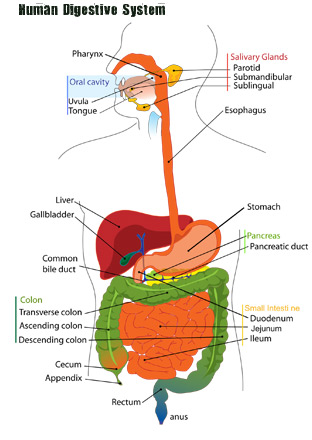Which Best Describes Food When It Reaches the Small Intestine
The food enters into the small intestine from the stomach in which the digestion of proteins begins. The digestion process can be divided into different stages such as digestion in the.
What Are The Correct Pathways Of Food In The Digestive System Quora
The middle part of your small intestine is the jejunum.

. The lower third portion of the small intestine about 12 feet long is called the ileum. The middle portion of the small intestine which is approximately 8 feet long is called the jejunum. The process by which digested food molecules are absorbed into the bloodstream and transported to different parts of the body is known as absorption.
The nutrients are further broken down by secretions from organs. 25 Assessment Choose the letter of the correct answer. Active enzymes from plants andor animals d.
Absorption of food begins with the small intestine. The digestive system is essentially a series of long hollow organs lined with muscles that contract in a rhythmic pattern known as peristalsis to. Which best describes food when it reaches the large intestine.
Cellulose digestion in ruminant mammals occurs before the ingested foods reach the small intestine E. The polysaccharides have been broken down. Which of the following best describes what happens to nutrients in the chyme as it travels through the small intestine.
The absorptive epithelial cells of the small intestine are called enterocytes. Which best describes food when it reaches the stomach. The earliest phase of digestion in which the brain prepares the body in.
Small Intestine It is where the final digestion of food takes place. Cellulose digestion in ruminant mammals occurs before the ingested foods reach the small intestine. Calcium sodium potassium and other minerals.
The pancreas secretes digestive juices into the duodenum which breaks down most of the materials in the small intestine. Here food is squirted from the stomach into the small intestine. All of the amino acids b.
The finger-like projections known as villi drastically increase the surface area of the small intestine for greater absorption of the digested food. The ileum absorbs bile acids fluid and vitamin B-12. In the stomach the enzyme pepsin acts on the peptide bonds of the protein and break it down into the smaller proteins.
The digested food molecules pass through the walls of the small intestine and then into the bloodstream. By the time food remains have reached this point about. This is where the final parts of digestive absorption take place.
Then they are taken up by intestinal lining cells and digested further by intracellular enzymes. The phase in which semi-digested food leaves the stomach and slowly enters the small intestine. The phase in which the majority of absorption occurs primarily in the small intestine.
When food now churned into a substance called chyme enters the small intestine the pancreas releases its own digestive enzymes to help break down starch says Frontiers in Nutrition s research. The essential nutrients for proper human nutrition include _____. The blood carries the absorbed food material to different parts of the body.
Rectum It is where the food enters. Food begins its journey through the digestive system in the mouth before being pushed by a series of involuntary muscle contractions through the esophagus then the stomach and then the small and large intestines. The first portion of the small intestine is called the duodenum.
The duodenum is the first part. The middle section of the small intestine carries food through rapidly with wave-like muscle contractions towards the ileum. Most of the nutrients have been removed.
ORGANS FUNCTIONS YES NO Mouth It is where the food is chewed and cut into smaller pieces. The lowest part of your small intestine is the ileum. The ileum is where most of the nutrients from your food are absorbed before emptying into the large intestine.
By the time food reaches your. It has been converted to urine. The small intestine is made up of several parts called the duodenum jejunum and ileum.
It has been broken down into small proteins. Undigested remains of food are passed through a one-way muscular valve into the first part of the large intestine known as the caecum a small pouch that acts as a temporary storage site. By the time food has reached the small intestine it has been broken down into small proteins.
It has been converted to polysaccharides. The teeth of herbivores tend to be sharper than the teeth of carnivores The ruminants are front-end fermenters with mutualistic microbes residing in chambers or. This last section is the longest part of your small intestine.
Absorption of Digested Food. In addition iron is absorbed in the duodenum. Large Intestine It stores the undigested food.
The small intestine is the main site for the digestion of chyme and absorption of the nutrients from the digested material. Digestion includes a complex combination of mechanical and chemical processes. The food that is digested is absorbed into the blood vessels in the walls of the intestine.
Some of the activities in the process include ingestion and propulsion of food mechanical or physical digestion chemical. The duodenum receives partially digested food called chyme through the pylorus from the stomach receives digestive enzymes from the pancreas and liver to continue to break down ingested food. The final phase of digestion in which the large intestine and rectum prepare the undigested components of food for elimination.
Carbohydrates fats minerals proteins and vitamins. Esophagus It is the passageway for air. The jejunum absorbs most of your nutrients.
Each segment of the small intestine has a different function including.

Digestive System Untamed Science
Which Carries Digested Food From The Small Intestine To The Bloodstream Quora
Comments
Post a Comment